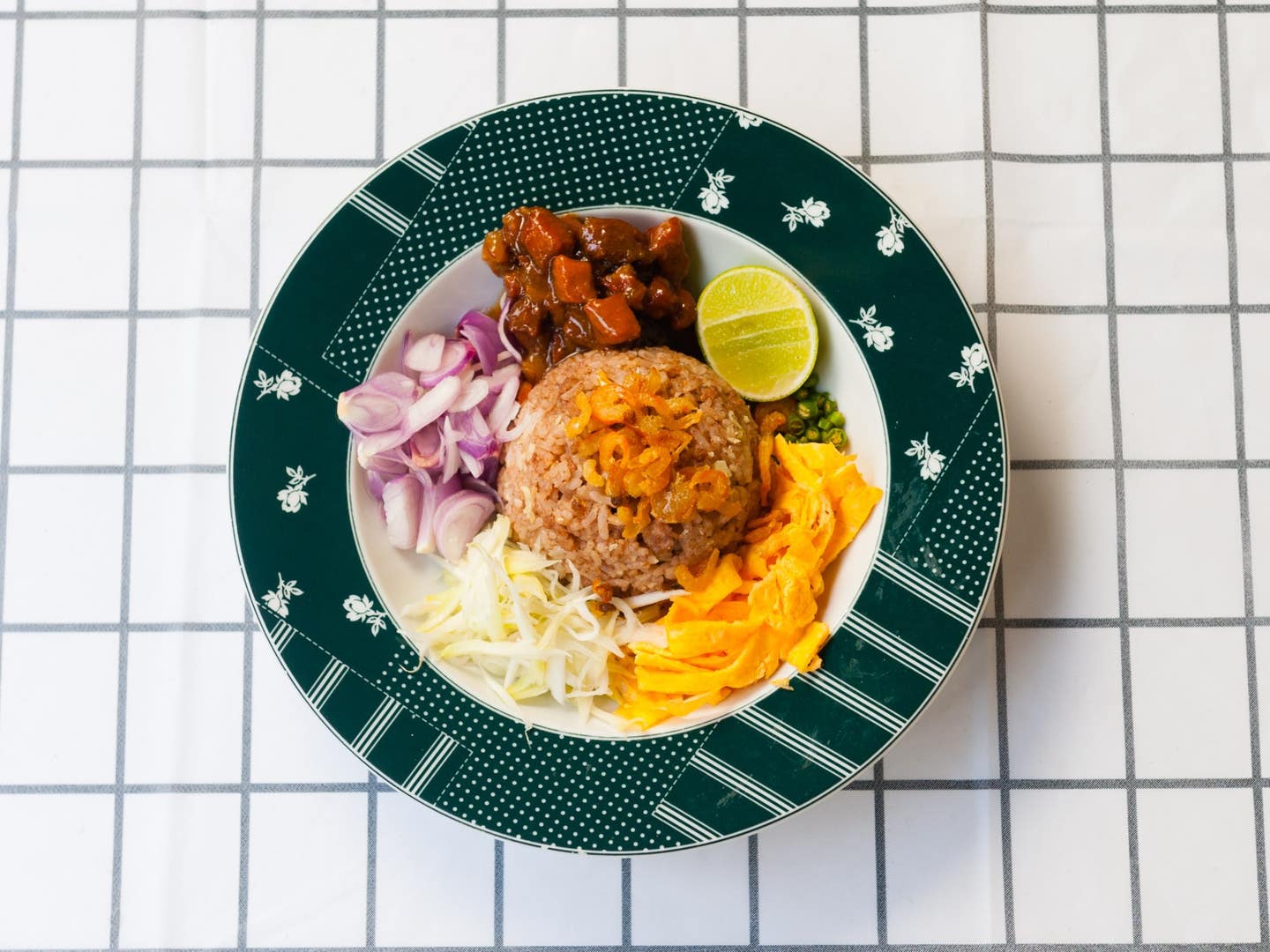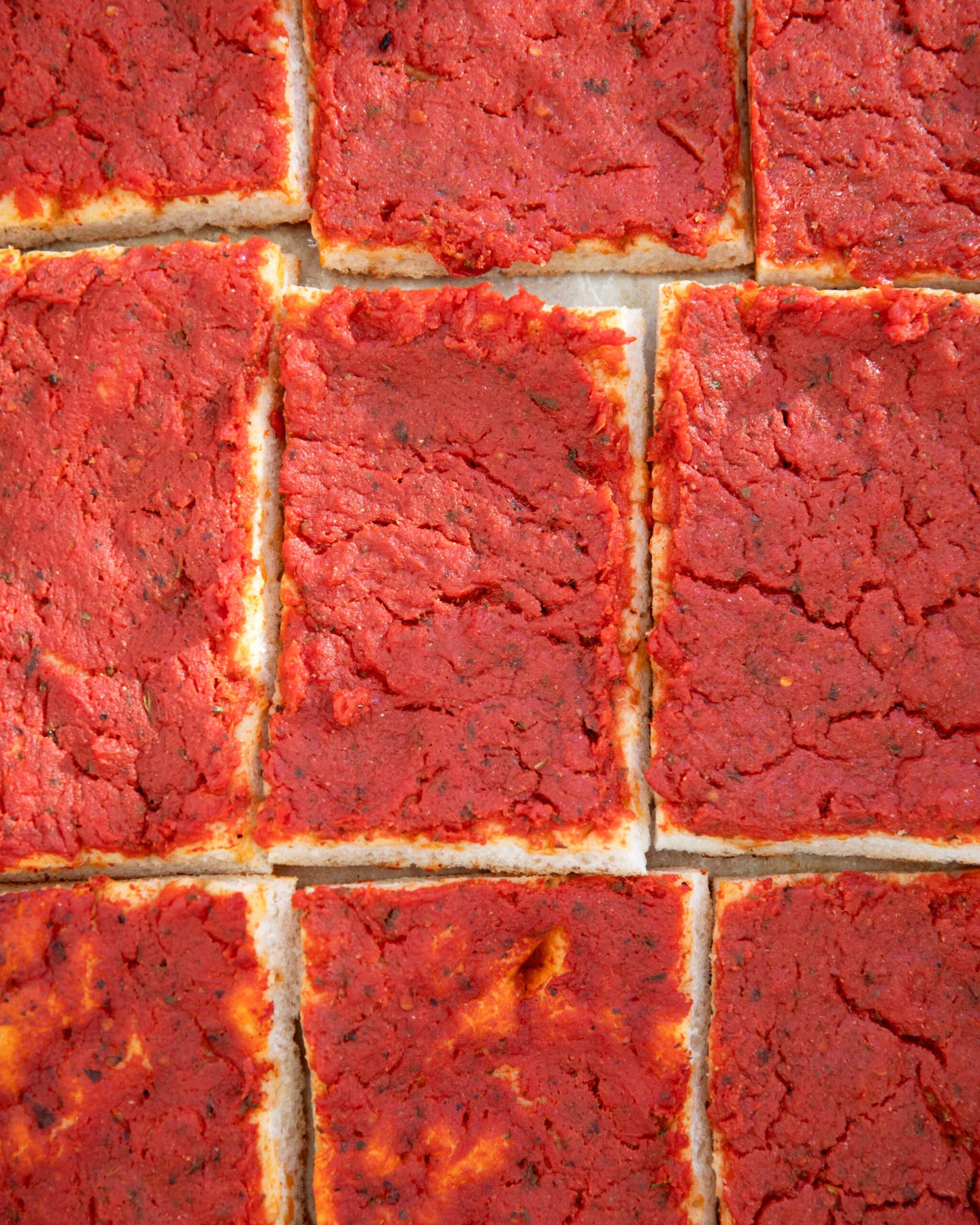Khao Khluk Kapi (Bangkok Rice with Shrimp Paste and Sweet Pork)
Crunchy, salty, sweet, and tart—this classic Thai dish has it all.
- Serves
serves 4
- Time
1 hour 45 minutes

While pad Thai was invented in Thailand, it has palpable Chinese influences; khao khluk kapi, on the other hand, could be considered an even more emblematically Thai dish. In this version, from Apavinee “Taew” Indaransi, owner of Bangkok’s Baan Varnakovida, long-grain rice is seasoned and topped with ingredients that speak to the region’s bright and diverse flavors, aromas, and textures, from sweet braised pork to tart green mango to bracing raw shallot to crispy dried shrimp. Find Thai-style shrimp paste, black soy sauce, and palm sugar at your local Asian grocery store, or order them online from Kalustyan’s.
Ingredients
For the sweet pork:
- 2 large cilantro roots (including a bit of green stem), finely chopped (2 Tbsp.)
- 2 medium garlic cloves, thinly sliced
- 1 tbsp. lard
- 6 small shallots, peeled and thinly sliced (1½ cups)
- ¼ cups (3½ oz.) soft palm sugar
- 10½ oz. pork neck, cubed
- 1 tsp. kosher salt
- ½ tsp. Thai black soy sauce
For the rice:
- 1 cup Thai long-grained rice
- 1 tbsp. lard
- 2 medium garlic cloves, finely chopped
- 1½ oz. ground pork
- 2 tbsp. Thai shrimp paste
- ¼ cups vegetable oil
For the crispy shrimp and the egg ribbons:
- ⅓ cups (1 oz.) small dried shrimp
- 2 large eggs, beaten
For serving:
- 1 small green (unripe) mango
- 24 very small bird’s eye chilies, thinly sliced (1 Tbsp.)
- 8 small shallots, peeled and thinly sliced (2 cups)
- Lime wedges
Instructions
Step 1
Step 2
Step 3
Step 4
Step 5
Step 6
- Up to 3 days before you plan to serve the dish, make the sweet pork: Using a mortar and pestle, pound the cilantro roots and garlic to a coarse paste. Set aside. In a medium pot over low heat, heat the lard. Add the reserved cilantro root and garlic paste, and cook, stirring frequently, just until fragrant, about 1 minute. Add the shallots and continue cooking, stirring frequently, until translucent, 2–4 minutes more. Add the palm sugar and continue cooking until the sugar has melted and is beginning to caramelize, about 5 minutes. Add the pork neck, 1 cup of water, the black soy sauce, and the salt. Turn the heat to medium high, bring to boil, then lower the heat to simmer and cook, stirring occasionally, until nearly all the water has evaporated, and the mixture is dark, syrupy and fragrant, around 45 minutes. Remove from heat and set aside to cool to room temperature.
- At least a couple hours before serving, make the rice: Place the grains in a small pot and rinse well until the water runs clear. Strain off the water, then measure 1 cup of fresh water into the pot. Over high heat, bring the mixture to a rapid boil for 2 or 3 seconds, then turn the heat as low as possible, cover, and cook the rice for 20 minutes. Remove from the heat and remove the lid for a few seconds to let the excess heat and moisture escape. Return the lid and let the rice rest until it has soaked up any residual heat and moisture and is starting to separate into distinct grains, about 10 minutes. Stir gently and set aside, covered, at room temperature.
- To a wok or large skillet over medium heat, add the lard. When hot, add the garlic and stir-fry until golden, about 30 seconds. Add the ground pork and continue stir-frying until just cooked through, about 1 minute more. Add the shrimp paste, and continue stir-frying until fragrant, about 2 minutes. Add ¼ cup of water, lower the heat to simmer and and cook, stirring occasionally, until the mixture has reduced to the the consistency of a chunky pasta sauce, about 5minutes. Gently stir in the reserved rice to combine, then transfer to a medium bowl and set aside to cool to room temperature.
- Meanwhile, make the crispy shrimp and the egg ribbons: Line a heatproof plate with paper towels and set it by the stove. Wipe out the wok and set over medium-high heat; add the vegetable oil and, when the oil is hot, add the shrimp and fry, stirring occasionally, until crispy, golden and very fragrant, about 30 seconds. Using a spider skimmer or slotted metal spoon, transfer the shrimp to the lined plate and set aside. Pour any excess oil off into a heatproof jar and reserve for another use. Return the wok to the stove, turn the heat to low and add the eggs, tilting and swirling the wok to distribute in a very thin, even layer. Fry, shifting the wok to ensure that the omelet cooks evenly, around 1 minute. Using a thin spatula, flip the omelet and continue cooking on the opposite side, around 15 seconds. Remove from heat. When the omelet is cool enough to handle, roll it into a tight cylinder, then slice into thin ribbons. Set aside to cool to room temperature.
- Shred the mango: Using a vegetable peeler, peel the mango, then, using a sharp knife, make shallow, lengthwise incisions on one side of the fruit. Then, turn the knife crosswise and shave down along the surface of the mango, resulting in thin, irregular strands. Repeat with the remaining mango.
- To serve, divide the reserved rice among four medium plates. Around each mound of rice, arrange ¼ of the sweet pork, ¼ of the omelet ribbons, ¼ of the shredded mango, ¼ of the sliced chiles, and ¼ of the sliced shallots; top each rice mound with crispy shrimp and a lime wedge and serve at room temperature.
Keep Reading
Continue to Next Story










